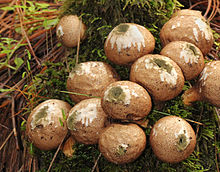Pear dusting
| Pear dusting | ||||||||||||
|---|---|---|---|---|---|---|---|---|---|---|---|---|

Pear dusting ( Apioperdon pyriforme ) |
||||||||||||
| Systematics | ||||||||||||
|
||||||||||||
| Scientific name | ||||||||||||
| Apioperdon pyriform | ||||||||||||
| ( Schaeff. ) Vizzini |
The Pear Puffball ( Apioperdon pyriforme , Syn. : Pyriforme Lycoperdon and Morganella pyriformis ) is a fungal art from the family of mushroom relatives (Agaricaceae). It is widespread, very common in Central Europe and is the only stub that grows on wood here. Young, white-fleshed fruit bodies are edible, later the mushroom is inedible.
features
Macroscopic features
The tufted, pear-shaped fruit body has a spherical top and a tapered base. It measures 2–3.5 (–5) cm in diameter and reaches a height of 1–5 (–8) cm. The surface is covered with fine spines at a very young age, which soon fall off and leave a soft, smooth structure. Later, the outer shell takes on a paper-like consistency and tears at the top when it is ripe. The spores enter the open air as (olive) brown dust through this opening. The color is cream when young and later turns pale brown. The fruit mass is initially white and firm, later turns yellowish to brownish olive-green and matures into a fluffy, dusty structure. Under the gleba chamber, the meat remains white into old age. Fruit body remnants often outlast the winter. The meat tastes mild and smells unpleasantly gaseous. There are white, branched mycelial strands at the base of the stem .
Microscopic features
The olive-brown spores measure 3 to 4.5 micrometers, round in shape, smooth on the surface and without a pedicelle .
ecology
The species lives as a saprobiont in dead wood and produces fruit from August to November. It is common in many parts of the world and very common at least in Europe and North America.
Systematics and taxonomy
The official scientific first description appeared in 1774 in a work by Jacob Christian Schäffer . The type epithet "pyriforme" comes from Latin and means "pear-shaped". A study published in 2001 by Dirk Krüger of compiled genetic material investigation material and a number of other mycologists suggest that the genus Lycoperdon is polyphyletic and that the pear dusting stands out most strongly from the group. This is supported by several morphological features such as the presence of rhizomorphs and that it grows on wood. A publication from 2003 located him in the genus Morganella and changed the ending of the epithet to "pyriformis" for reasons of congruence . In a paper Phylogenetik der Lycoperdaceae published in 2008, Larsson and Jeppson continue to assign the species to the genus Lycoperdon , taking into account more species that have been studied . Since 2017, the pear dusting has been assigned to the genus Apioperdon .
meaning
They can be eaten immature (as long as the meat is white) and are used as edible mushrooms . The meat becomes slimy and often gelatinous when cooked.
swell
literature
- Brian Spooner: Mushrooms of Central Europe. Munich 1999, ISBN 3-576-11347-9 .
- Jean-Marie Polese: Pocket Guide Mushrooms. Cologne 1999, ISBN 3-8290-2906-3 .
- Hans E. Laux: The great cosmos mushroom guide. All edible mushrooms with their poisonous doppelgangers. Franckh-Kosmos, Stuttgart 2001, ISBN 3-440-08457-4 , p. 612.
- Hans E. Laux: Edible mushrooms and their poisonous doppelgangers . Collect mushrooms - the right way. Kosmos Verlags-GmbH, Stuttgart 2005, ISBN 3-440-10240-8 , p. 90 .
- Markus Flück: Which mushroom is that? 3. Edition. Franckh-Kosmos Verlag, Stuttgart 2009, ISBN 978-3-440-11561-9 , pp. 356 .
Individual evidence
- ↑ a b Michael Kuo: Morganella pyriformis. In: MushroomExpert.com website. Retrieved September 30, 2011 .
- ^ Jacob Christian Schaeffer: Fungorum qui in Bavaria et Palatinatu Nascuntur Icones . tape 4 , 1774, pp. 128 (Latin).
- ↑ Dirk Krüger, Manfred Binder, Michael Fischer, Hanns Kreisel: The Lycoperdales . A molecular approach to the systematics of some gasteroid mushrooms. In: The Mycological Society of America (Ed.): Mycologia . tape 93 , no. 5 , September – October, 2001, pp. 947-957 (English, researchgate.net ).
- ^ Dirk Krüger, Hanns Kreisel: Proposing Morganella subgen. Apioperdon subgen. nov. for the puffball Lycoperdon pyriform . In: Mycotaxon . tape 86 , April-June, 2003, pp. 169-177 (English, cybertruffle.org.uk ).
- ↑ Ellen Larsson, Mikael Jeppson: Phylogenetic relationships among species and genera of Lycoperdaceae based on ITS and LSU sequence data from north European taxa . In: Mycological Research . tape 112 , no. 1 , January 2008, p. 4-22 , doi : 10.1016 / j.mycres.2007.10.018 , PMID 18207380 (English).
- ^ Vizzini, Alfredo; Ercole, Enrico: Detecting the phylogenetic position of Bovista acuminata (Agaricales, Basidiomycota) by an ITS-LSU combined analysis: the new genus Bryoperdon and revisitation of Lycoperdon subgen. Apioperdon . In: Phytotaxa . Vol 299, No. 1, March 17, 2017, ISSN 1179-3163 , p. 77-86 , doi : 10.11646 / phytotaxa.299.1.5 ( biotaxa.org [accessed January 30, 2020]).
Web links
- Frank Moser: Pear dusting ( Lycoperdon pyriforme ). In: Natur-Lexikon.com. Retrieved on August 14, 2012 (species portrait).
- Jürgen Marqua: Caramelized pear dusters with vanilla ice cream and raspberry sauce. (No longer available online.) In: Fungiworld.com. September 15, 2006, archived from the original on January 23, 2013 ; accessed on August 14, 2012 (prescription).

